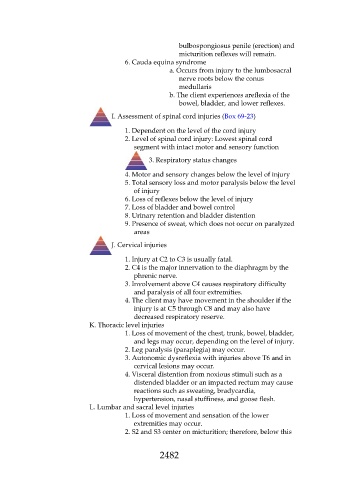Page 2482 - Saunders Comprehensive Review For NCLEX-RN
P. 2482
bulbospongiosus penile (erection) and
micturition reflexes will remain.
6. Cauda equina syndrome
a. Occurs from injury to the lumbosacral
nerve roots below the conus
medullaris
b. The client experiences areflexia of the
bowel, bladder, and lower reflexes.
I. Assessment of spinal cord injuries (Box 69-23)
1. Dependent on the level of the cord injury
2. Level of spinal cord injury: Lowest spinal cord
segment with intact motor and sensory function
3. Respiratory status changes
4. Motor and sensory changes below the level of injury
5. Total sensory loss and motor paralysis below the level
of injury
6. Loss of reflexes below the level of injury
7. Loss of bladder and bowel control
8. Urinary retention and bladder distention
9. Presence of sweat, which does not occur on paralyzed
areas
J. Cervical injuries
1. Injury at C2 to C3 is usually fatal.
2. C4 is the major innervation to the diaphragm by the
phrenic nerve.
3. Involvement above C4 causes respiratory difficulty
and paralysis of all four extremities.
4. The client may have movement in the shoulder if the
injury is at C5 through C8 and may also have
decreased respiratory reserve.
K. Thoracic level injuries
1. Loss of movement of the chest, trunk, bowel, bladder,
and legs may occur, depending on the level of injury.
2. Leg paralysis (paraplegia) may occur.
3. Autonomic dysreflexia with injuries above T6 and in
cervical lesions may occur.
4. Visceral distention from noxious stimuli such as a
distended bladder or an impacted rectum may cause
reactions such as sweating, bradycardia,
hypertension, nasal stuffiness, and goose flesh.
L. Lumbar and sacral level injuries
1. Loss of movement and sensation of the lower
extremities may occur.
2. S2 and S3 center on micturition; therefore, below this
2482

